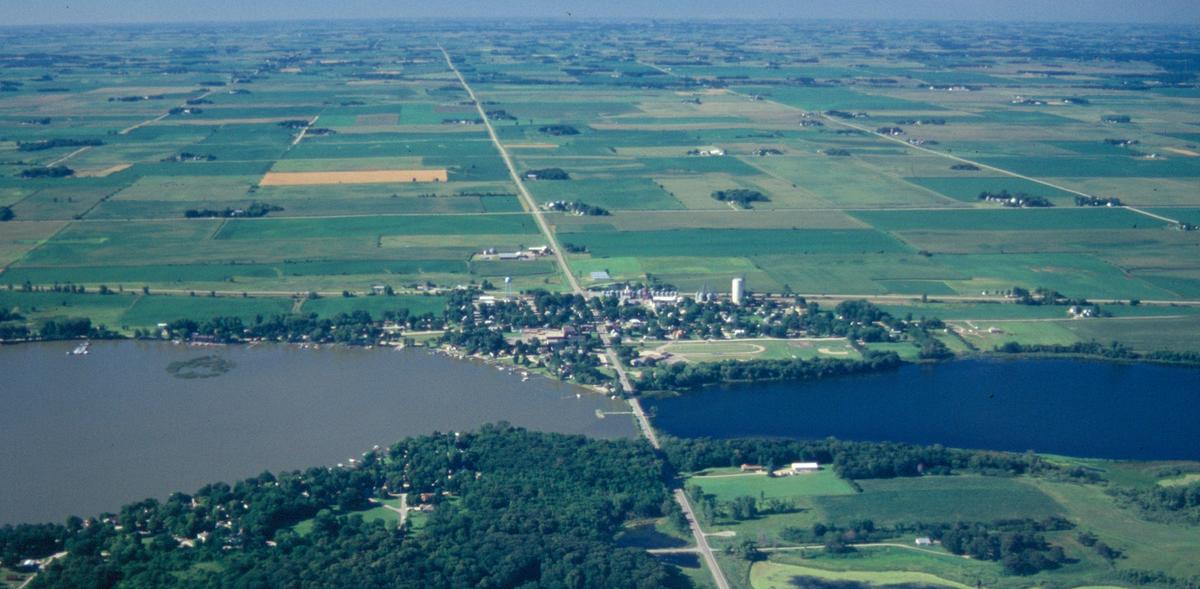
The lake on the left in the photo above is opaque or murky because the presence of carp encourage algae growth and the fish stir up sediment from the lake bottom. The lake on the right used to look murky too. Scientists removed the carp and within a few days the water became clearer. Ironically, the murky lake's name is Clear Lake. The other lake is Ventura Lake. Image credit: John A. Downing.
Objectives. The objectives of this project are to determine how carp affect carbon sequestration and greenhouse gas emissions from 18 Minnesota lakes and determine both the climate change and economic benefits of carp removal.
The project team will analyze 18 lakes:
- With established, abundant (>100 kg/ha) carp
- Where carp have been eradicated
- Lakes in which carp have not been detected by fish monitoring
Scientists will measure the abundance of carp and aquatic macrophytes in the 18 lakes and estimate sediment accumulation rates and greenhouse gas emissions, including carbon dioxide (CO2), methane (CH4), and nitrous oxide (N2O).
Why. Carp are known to be deleterious to the social value and quality of lake water, but it's quantitatively unknown how carp affect the accumulation of carbon (C) in lake sediment and how carp might exacerbate greenhouse gas emissions.
Who. The project team's goal is to provide analyses that gives lake managers at the Minnesota Department of Natural Resources, other agencies, tribes, and policy makers the applied tools they can use to determine how to optimally apply carp management to Minnesota lakes.
Funding
Funding for this project was provided by the Minnesota Environment and Natural Resources Trust Fund as recommended by the Minnesota Aquatic Invasive Species Research Center (MAISRC) and the Legislative-Citizen Commission on Minnesota Resources (LCCMR).
Project funding comes from the Environment and Natural Resources Trust Fund as recommended by the Legislative-Citizen Commission on Minnesota Resources.
Lake restoration needs are great in Minnesota but restoration funding cannot meet demands.
The project team seeks to develop valuable, cost-effective solutions and build economic and social support for carp management and other aquatic invasive species (AIS) control measures.
Outreach plan
The project team seeks to harness the extension education/outreach and communication capabilities of Minnesota Sea Grant and MAISRC to disseminate these results to managers, policy makers, planners and the media.
Project team
Project Manager:
John A. Downing
downing@d.umn.edu
Professor and Minnesota Sea Grant Director
University of Minnesota Duluth and University of Minnesota
Przemyslaw Bajer
bajer003@umn.edu
Research Assistant Professor
Department of Fisheries, Wildlife and Conservation Biology
University of Minnesota
Brian Huser
brian.huser@slu.se
Research Associate Professor
Department of Aquatic Sciences and Assessment
Swedish University of Agricultural Sciences
Joe Rabaey
rabae005@umn.edu
Postdoctoral Fellow
Minnesota Sea Grant and Large Lakes Observatory
University of Minnesota Duluth and University of Minnesota
Why Sea Grant?
This project supports two of Minnesota Sea Grant's focus areas: Healthy Coastal Ecosystems and Resilient Communities and Economies.
A guiding principle of this work is that findings need to be translated quickly to management actions.
Lead scientist(s)
John A. Downing
downing@d.umn.edu
Director Minnesota Sea Grant
University of Minnesota Duluth and University of Minnesota